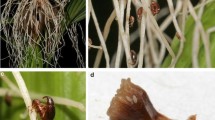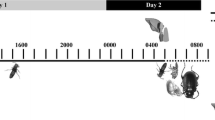Abstract
Steam-distilled floral oils (essences) from several species of Theobroma (Sterculiaceae) (T. cacao Linneaus, T. simiarum Donn. Smith, T. mammosum Cuatr. & Leon, and T. speciosum Willd.) were tested using McPhail traps, in an abandoned Costa Rican cocoa plantation to determine their levels of attraction for flying insects. In each of the three bioassays (two successive dry seasons and one intervening rainy season), the traps were inoculated with floral scents at 1, 10, and 100 ppm, while controls were inoculated with a 10% solution of chloroform solvent in distilled water. Of a total of 223 Diptera captured in all three bioassays, only 5% were found in the controls, indicating attraction to the floral oil. About 72% of all Diptera captured were Cecidomyiidae, of which three species, Mycodiplosis ligulata Gagne, Aphodiplosis triangularis (Felt.) and Ledomyia sp., comprised 59% of the total. Eighty-eight per cent of all midges captured were females. Only 7% of the total were known cocoa-pollinating midges of Ceratopogonidae, and all of these were females. Sixteen per cent were Phoridae, known pollinators of the allied genus Herrania in Costa Rica. Although the chemical composition of floral oils varies greatly among the species of Theobroma, no discernible differences were found in the attraction of midges to floral oils tested. While floral fragrances in Theobroma species may represent a generalized adaptation for dipteran pollination, small numbers of several species of Trigona bees (Hymenoptera: Apidae: Meliponinae) were also attracted to the floral oils.
Résumé
Des essences florales distillées par vapeur à partir de plusieurs espèces de Theobroma (Sterculiaceae) (T. cacao Linnaeus, T. simiarum Donn. Smith, T. mammosum Cuatr. & Leon, et T. speciosum Willd.) ont été testées en utilisant des pièges McPhail dans une plantation de cacao abandonee du Costa Rica pour déterminer leur degré d’attraction pour des insectes volants. Au cours de chacun des trois bioessais (deux saisons sèches successives et une saison des pluies intermediare), les pièges ont été inoculés avec des essences florales au 1, 10 et 100 millionième tandis que des contrôles étaient inoculés avec une solution de 10% de solvent de chloroforme dans de l’eau distillée. Sur un total de 223 diptères capturés au cours des trois bioessais seulemnt 5% ont été trouvés dans les contrôles indiquant une attraction pour les essences florales. Environ 72% de tous les diptères capturés des Cecidomyiidae et dont 59% du total étaient représentés per trois espèces, Sfycodiplosis ligulata Gagne, Aphodiplosis triangularis (Felt) et Ledomyia sp. Quatre-ving huit pour cent de tous les moucherons captures étaient femelles. Suelemnt 7% du total étaient des moucherons poiliniseurs de cacao Ceratopogonidae et tous étaient femelles. Seize pour cent étaient des Phoridae poiliniseurs connus du genre allié Herrania au Costa Rica. L’attraction pour les essences florales était similaire pour toutes les espèces de Theobroma a l’exception de T. speciosum, qui était très basse: Theobroma speciosum n’est pas endémique au Costa Rica. Tandis que les senteurs florales dans les espèces Theobroma peuvent représenter une adaptation généralisée pour la pollinisation par diptères, un petit nombre de plusieurs espèces d’abeilles Trigona (Hymenoptera: Apidae: Meliponinae) étaient aussi attirées par les essences florales. Les données concernant les insectes sont discutées en termes de différences entre les espèces Theobroma pour les principaux constituents volatiles des essences florales distillées.
Similar content being viewed by others
References
Bennett F.D. (1972) Baited McPhail fruitfly traps to collect euglossine bees. J. New York Ent. Soc, 137–145.
Cuatrecasas J. (1964) Cacao and its allies—a taxonomic revision of the genus Theobroma. Contribution of U.S. Natural Museum 35, 379–614.
Entwistle P.F. (1972) Pests of Cocoa. Longmans, London.
Erickson B.J., Young A. M., Strand M.A. and Erickson E.H. Jr. (1987) Pollination biology of Theobroma and Herrania (Sterculiaceae). II. Analyses of floral oils. Insect Sci. Applic. 8, 301–310.
Hernandez J. (1965) Insect pollination of cacao (Theobroma cacao L.) in Costa Rica. Doctorate Dissertation, University of Wisconsin, Madison.
Posnette A.F. (1944) Pollination of cacao in Trinidad. Trop. Agric. 21, 115–118.
Soetardi R.G. (1950) De Betekenis van Insecten Gij Bestuiving van Theobroma cacao L. Archiv. Koffiecult. Indonesie 17, 1–31.
Sorta S. de J. (1970) Studies on Forcipomyia spp. midges (Diptera: Ceratopogonidae) related to the pollination of Theobroma cacao L. Doctorate Dissertation, University of Wisconsin, Madison.
Wille A. (1983) Corcovado. Edit. EUNED, San Jose, Costa Rica.
Winder J.A. (1978) Cocoa flower Diptera: Their identity, pollinating activity and breeding sites. PANS 24, 5–18.
Young A.M. (1981) The ineffectiveness of the stingless bee, Trigona jaty (Hymenoptera: Apidae: Meliponinae) as a pollinator of cocoa (Theobroma cacao L.). J. appl. Ecol. 18, 149–155.
Young A.M. (1983) Seasonal differences in abundance and distribution of cocoa-pollinating midges in relation to flowering and fruit-set between sunny and shaded habitats of the La Lola Cocoa Farm in Costa Rica. J. appl. Ecol. 20, 801–831.
Young A.M. (1984) Mechanism of pollination by Phoridae (Diptera) in some Herrania species (Sterculiaceae) in Costa Rica. Proc. Ent. Soc. Wash. 86, 503–518.
Young A.M. (1985a) Studies of cecidomyiid midges (Diptera: Cecidomyiidae) as cocoa pollinators in Central America. Proc. Ent. Soc. Wash. 87, 49–79.
Young A.M. (1985b) Pollen collecting by stingless bees on cacao flowers. Experientia 41, 760–762.
Young A.M. (1986a) Cocoa Pollination. Cocoa Grow. Bull. 37, 5–23.
Young A.M. (1986b) Distribution and abundance of Diptera in flypaper traps at Theobroma cacao L. (Sterculiaceae) flowers in Costa Rican cacao plantations. J. Kansas Ent. Soc. 59, 580–587.
Young A.M. (1986c) Habitat differences in cocoa tree flowering, fruit-set and pollinator availability in Costa Rica. J. Trop. Ecol. 2, 163–186.
Young A.M., Erickson E.H., Jr. Strand M.A. and Erickson B.J. (1987) Pollination biology of Theobroma and Herrania (Sterculiaceae). I. Floral biology. Insect Sci. Applic. 8, 151–164.
Author information
Authors and Affiliations
Additional information
Mention of a proprietary product does not constitute an endorsement or a recommendation for its use by the USDA.
Rights and permissions
About this article
Cite this article
Young, A.M., Erickson, B.J. & Erickson, E.H. Pollination Biology of Theobroma and Herrania (Sterculiaceae) — III. Steam-Distilled Floral Oils of Theobroma Species as Attractants to Flying Insects in a Costa Rican Cocoa Plantation. Int J Trop Insect Sci 10, 93–98 (1989). https://doi.org/10.1017/S1742758400003404
Received:
Revised:
Published:
Issue Date:
DOI: https://doi.org/10.1017/S1742758400003404




